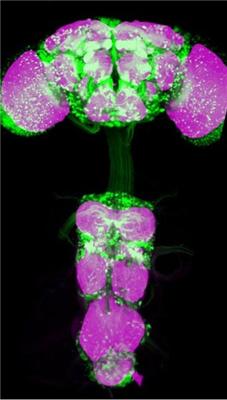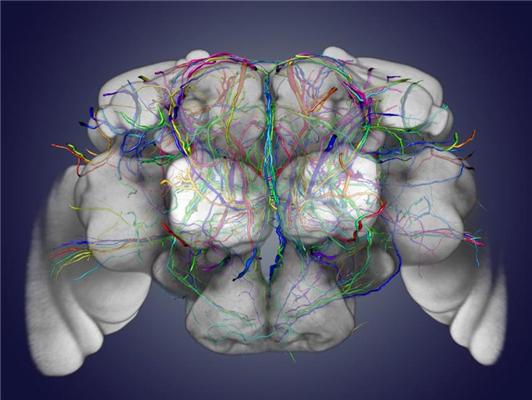Not only do animals come in different shapes and sizes, but they all exhibit different behaviors as well - each species is born with its own unique set of innate behaviors but how they are controlled by the brain is not well understood. Drosophila melanogaster , the 'fruit fly', is a big help in this sort of research because sex is a behavior the fruit fly does well. Their reproductive prowess has ensured their place throughout the world.
Unlike human men, the male fruit fly is born knowing how to get females - its brain is fully equipped with the right neurons that allow it to perform an intricate mating dance to woo the female for copulation.
Now, researchers from the Institute of Molecular Pathology (IMP), in Vienna, Austria, and the Laboratory of Molecular Biology (LMB/MRC), Cambridge, United Kingdom, have mapped the neurons of Drosophila that control sexual behavior. “We literally untangled the mess of wires in the fly brain and laid the ground plans for investigating a complex behavior in a simple organism,” says Jai Yu, whose doctoral work is the basis for the study.

Fruit fly neurons in the CNS, shown in green. Synapses are stained in magenta. This is a confocal image of the brain and ventral nerve cord of a fruGAL4 UAS-GFP male. Credit: Institute of Molecular Pathology
Yu viewed individual types of neurons in the brain of the fruit fly that are known to be important in controlling its mating dance, or courtship dance. Those neurons are called fruitless neurons because they express a critical gene, fruitless, that is needed for fruitful reproduction. “At the beginning, we knew there’s about 2% of the fly brain, which is around 1500 individual neurons, that are important for courtship, but we didn’t know how many types or groups of neurons they belong to. We now know there are at least 100 different types based on where they connect to,” says Jai Yu, “We think each type of neuron is important in some way and together all the components work together hand in hand to generate the courtship dance.”
This work was possible by looking at the miniscule brains, at less than a millimeter across, of thousands of different genetic strains of Drosophila, each one having a different group of neurons made visible with a fluorescent protein. “It was like a giant jigsaw puzzle, where we each fly strain provided a piece and we had to put together the complete picture one strain at a time,” explains Jai Yu. After analyzing a large collection of images of fruit fly brains using a combination of microscopy and advanced digital imaging software, Jai Yu could connect the pieces and reveal a map of mating dance neurons, “What we did was similar to making an electronic circuit diagram, looking at how the parts are connected.”

Genetic dissection of drosophila neurons in the central brain. Distinct neuronal cell types have been labeled, imaged, and traced in different colours. A synaptic counterstain was used to register individual samples onto a common reference brain, creating a digital atlas of the fru circuit. Credit: Institute of Molecular Pathology
The findings opens up many avenues of research, particularly it offers a chance to really know how these 100 different types of neurons in the fly nervous system orchestrate the mating dance.
“I look forward to a time in the near future, where we can understand what goes on in the brain of the little fruit fly, how it has become so efficient at doing things, eat, sleep and reproduce,” says Jai Yu, “I hope through our efforts, the brain will become less of a mystery and more of a tangible entity that we can one day understand.”
Citation: Yu, J.Y., Kanai, M., Demir, E., Jefferis, G.S.X.E. and Dickson, B.J., 'Cellular organisation of the neural circuit that drives Drosophila courtship behaviour', Current Biology, September 28, 2010, Vol. 20, Nr. 18. pp. 1589-1601 DOI: 10.1016/j.cub.2010.07.045





Comments